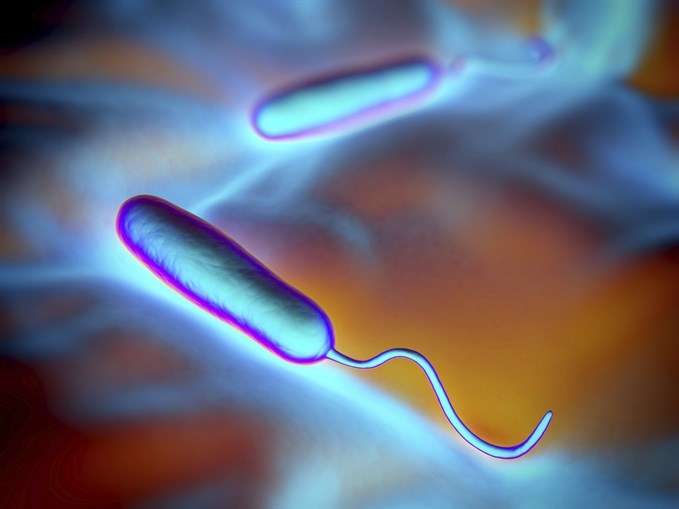Lele flagella motor research develops novel insights in cellular mechanics

Dr. Pushkar Lele, assistant professor in the Artie McFerrin Department of Chemical Engineering at Texas A&M University, is developing novel insights in cellular mechanics with bacteria to aid in the design of superior biomedical implants capable of resisting colonization by infectious bugs. Lele's group also focuses on unraveling the fundamental principles underlying interactions in biological soft-matter to build bio-nanotechnology-based molecular machines. Lele's lab currently focuses on a unique electric rotary device found in bacteria—the flagellar motor.
According to Lele, it is well established how motile bacteria employ flagellar motors to swim and respond to chemical stimulation. This allows bacteria to search for nutrients and evade harmful chemicals. However, in his recent work, Lele has now demonstrated that the motor is also sensitive to mechanical stimulation and identified the protein components responsible for the response. Sensing initiates a sensitive control of the assemblies of numerous proteins that combine to form the motor. Control over motor assemblies facilitates fine-tuning of cellular behavior and promotes chances of survival in a variety of environments.
"What is the sense of touch in a bacterium? It is likely that they employ appendages such as the flagella to detect solid substrates, analogous to our use of fingers," Lele said. "How they recognize the substrate using the flagellum has been a long-standing question in biology with tremendous biomedical significance. Our findings have provided a handle on this important problem. We now know [how] the motor-components [are] involved in sensing the substrate [and] would like to know how these sensors trigger signaling networks that ultimately cause infections. "
Lele and his group seek to understand how flagella enable cells to adapt to and interact with their environments. The group's current focus is on explaining at a molecular level the mechanisms that aid colonization and invasion on substrates, such as biomedical implants.
"We are building a set of tools and a level of understanding that will help us explain how cells recognize cues, adapt and ultimately survive repeated environmental challenges," Lele said. "Our emphasis is not necessarily on the destruction of the bug with antibiotics, because that is an assured way of promoting resistance. Rather, we want to approach this problem by tricking the cell into not recognizing the substrate, thereby indirectly camouflaging the substrate."
According to Lele, this could be achieved by interfering with cell-signaling and preventing the pathogens from getting a foothold. The body must then rid itself of the pathogens.
"Remove one of the important components in the signaling network," Lele said. "You can think of it in terms of 100 people communicating in a chain. If you remove a group of people, then that signal is interrupted. If the components can be deactivated, great; else we manipulate the incoming signal. We are not killing the cell, but the bug can no longer turn on the genes required for colonization."
These efforts by Lele and his group target an ever-growing public health concern —antibiotic resistance. Swarms of bacteria, or bacteria encased in biofilms, are prone to developing resistance to the most potent antibiotics currently in use. This research, Lele says, could potentially save lives in an industry where deaths resulting from catheter-associated urinary tract infections number from 10,000 to 13,000 each year. The applications, though, are not limited to the healthcare industry.
"Apart from the obvious implications for public health, a variety of industries stand to benefit from this type of work," Lele said. "Bacteria will cause mischief wherever they can. Bio-fouling of engineered materials is an old and expensive problem that costs industries billions of dollars each year."
The research Lele is doing is also related to the field of bio- nanotechnology. Using biological structures as a template, Lele and his collaborators aim to direct the self-assembly of artificial motors at these length-scales.
"A good reason to study such structures is that these are model systems for understanding complex phenomena at the nano-scale." Lele said. "How best can we emulate nature and direct the assembly of objects at the nano-scale? Considerable advances have been made in top-down as well as bottom-up techniques for building useful features at the tiniest length-scales. But the precision and functionalities that nature achieves [are] still beyond our reach: try building a smart electric device that can sense a variety of signals, act as a feedback controller, repair itself on demand and at the same time deliver an uninterrupted supply of power with ecofriendly fuel."
Lele credits his interdisciplinary training in chemical engineering, soft-matter and biophysics for being able to do this kind of work.
"There is something about movement at a molecular scale that is truly fascinating, whether you are an engineer, a physicist or a biologist," Lele said. "Once you have witnessed it, you want to explain it. We would like to go a step further and exploit our understanding to develop technologies that will hopefully make life a little easier."
Provided by Texas A&M University




















